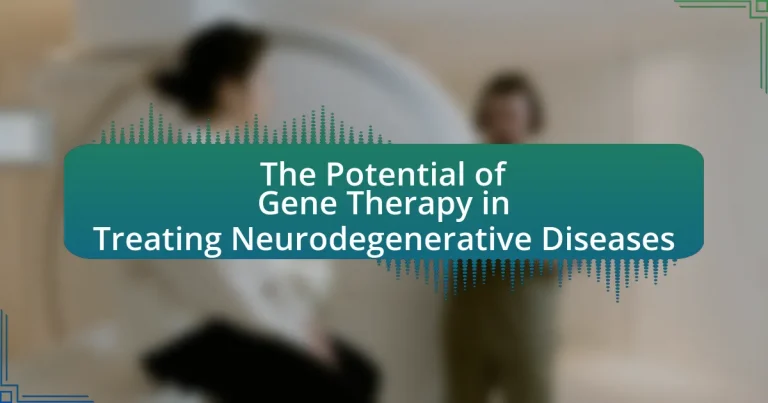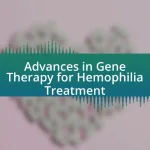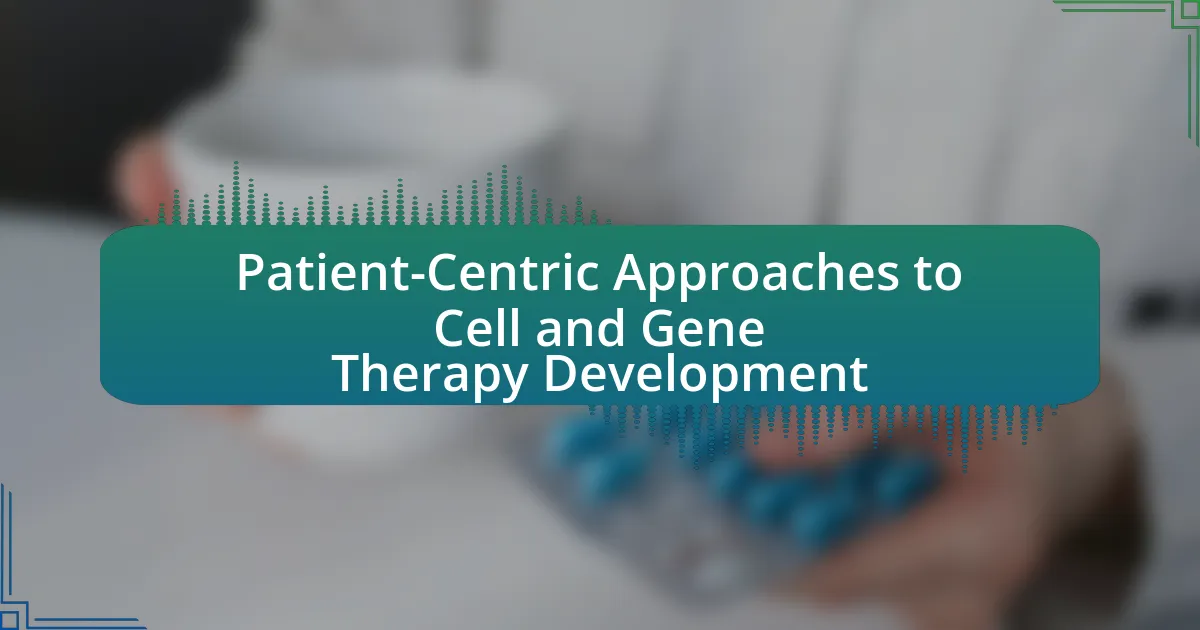Gene therapy represents a promising approach in the treatment of neurodegenerative diseases by addressing their genetic underpinnings. This article explores the mechanisms through which gene therapy targets conditions such as spinal muscular atrophy, Huntington’s disease, Alzheimer’s, and Parkinson’s disease, highlighting advancements in clinical trials and the use of technologies like CRISPR-Cas9 and adeno-associated viruses. It also discusses the differences between gene therapy and traditional treatments, the potential benefits for patients, and the challenges faced in its application, including delivery mechanisms and regulatory hurdles. Furthermore, the article examines the integration of gene therapy into existing treatment paradigms and the best practices for patients considering this innovative therapeutic option.
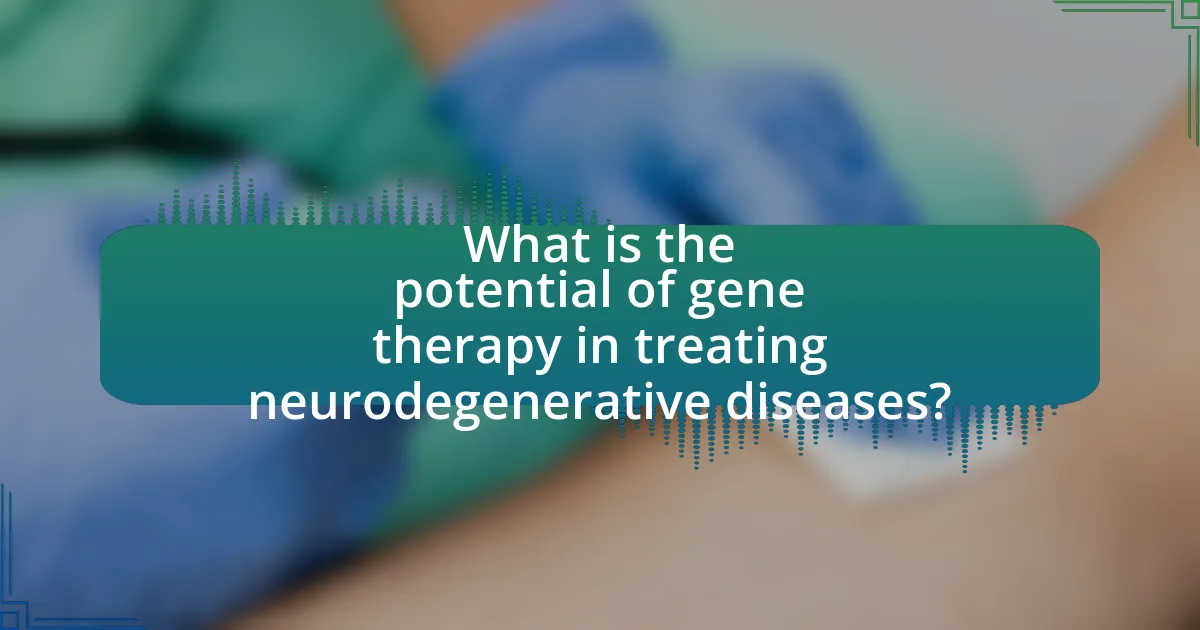
What is the potential of gene therapy in treating neurodegenerative diseases?
Gene therapy has significant potential in treating neurodegenerative diseases by targeting the underlying genetic causes of these conditions. This approach aims to correct or replace defective genes responsible for disease progression, as evidenced by advancements in clinical trials for conditions like spinal muscular atrophy and Huntington’s disease. For instance, the FDA-approved gene therapy Zolgensma has shown remarkable efficacy in treating spinal muscular atrophy by delivering a functional copy of the SMN1 gene, leading to improved motor function in patients. Additionally, ongoing research is exploring the use of adeno-associated viruses to deliver therapeutic genes directly to the brain, which could halt or reverse neurodegeneration. These developments indicate that gene therapy holds promise as a transformative strategy in the management of neurodegenerative diseases.
How does gene therapy target neurodegenerative diseases?
Gene therapy targets neurodegenerative diseases by delivering therapeutic genes to replace or repair defective genes responsible for disease progression. This approach can involve the use of viral vectors to introduce genes that encode for neuroprotective proteins, promote neuronal survival, or enhance cellular repair mechanisms. For instance, in conditions like Parkinson’s disease, gene therapy aims to restore dopamine production by delivering genes that encode enzymes involved in dopamine synthesis. Clinical trials have demonstrated the potential of this strategy, with studies showing improved motor function and reduced symptoms in patients receiving gene therapy interventions.
What are the mechanisms of action in gene therapy for these diseases?
Gene therapy for neurodegenerative diseases primarily operates through mechanisms such as gene replacement, gene editing, and gene silencing. Gene replacement involves introducing a functional copy of a gene to compensate for a defective or missing gene, thereby restoring normal function. Gene editing, utilizing technologies like CRISPR-Cas9, allows for precise modifications of the genome to correct mutations that cause disease. Gene silencing employs techniques such as RNA interference to inhibit the expression of harmful genes, reducing the production of toxic proteins associated with neurodegeneration. These mechanisms have been validated in various studies, demonstrating their potential to alter disease progression and improve patient outcomes in conditions like Alzheimer’s and Parkinson’s disease.
How does gene therapy differ from traditional treatments?
Gene therapy differs from traditional treatments by targeting the underlying genetic causes of diseases rather than just alleviating symptoms. Traditional treatments often focus on managing symptoms through medications or surgeries, which do not address the root cause of conditions like neurodegenerative diseases. In contrast, gene therapy aims to correct or replace defective genes responsible for disease progression, potentially offering a more permanent solution. For example, in conditions like spinal muscular atrophy, gene therapy has shown the ability to restore function by delivering a functional copy of the SMN1 gene, which traditional treatments cannot achieve.
What types of neurodegenerative diseases can gene therapy address?
Gene therapy can address several types of neurodegenerative diseases, including Alzheimer’s disease, Parkinson’s disease, Huntington’s disease, and amyotrophic lateral sclerosis (ALS). Research has shown that gene therapy approaches, such as delivering therapeutic genes to target cells, can potentially modify disease progression and alleviate symptoms in these conditions. For instance, studies have demonstrated that gene therapy can enhance neuroprotective factors in models of Alzheimer’s and Parkinson’s diseases, indicating its potential efficacy in treating these disorders.
Which specific diseases are currently being researched for gene therapy applications?
Currently, specific diseases being researched for gene therapy applications include spinal muscular atrophy, Duchenne muscular dystrophy, Huntington’s disease, and amyotrophic lateral sclerosis (ALS). Research has shown that gene therapy can potentially correct genetic defects or provide therapeutic benefits in these conditions. For instance, the FDA approved the gene therapy Zolgensma for spinal muscular atrophy, demonstrating its effectiveness in addressing the underlying genetic cause of the disease. Additionally, ongoing clinical trials are exploring the use of gene editing techniques, such as CRISPR, for treating Huntington’s disease and ALS, indicating a significant focus on these neurodegenerative disorders in the field of gene therapy.
What are the challenges in applying gene therapy to various neurodegenerative diseases?
The challenges in applying gene therapy to various neurodegenerative diseases include delivery mechanisms, immune responses, and the complexity of the diseases themselves. Delivery mechanisms are critical because effectively targeting the central nervous system with therapeutic genes remains difficult due to the blood-brain barrier, which restricts the passage of many substances. Immune responses pose another challenge, as the introduction of viral vectors used for gene delivery can trigger immune reactions that may diminish the therapy’s effectiveness or cause adverse effects. Additionally, the complexity of neurodegenerative diseases, characterized by multifactorial causes and progressive degeneration, complicates the identification of suitable gene targets and the development of effective therapies. These challenges highlight the need for ongoing research and innovation in gene therapy approaches for neurodegenerative conditions.
What are the potential benefits of gene therapy for patients?
Gene therapy offers significant potential benefits for patients, particularly in treating neurodegenerative diseases. It aims to correct or replace defective genes responsible for disease progression, potentially halting or reversing symptoms. For instance, in conditions like spinal muscular atrophy, gene therapy has demonstrated the ability to improve motor function and increase survival rates by delivering a functional copy of the SMN1 gene. Clinical trials have shown that patients receiving gene therapy can experience substantial improvements in quality of life and functional abilities, as evidenced by a study published in the New England Journal of Medicine, which reported a 50% increase in survival rates among treated patients compared to those receiving standard care.
How can gene therapy improve patient outcomes in neurodegenerative diseases?
Gene therapy can improve patient outcomes in neurodegenerative diseases by targeting the underlying genetic causes of these conditions, thereby potentially halting or reversing disease progression. For instance, in conditions like spinal muscular atrophy, gene therapy has been shown to deliver a functional copy of the SMN1 gene, leading to significant improvements in motor function and survival rates. Clinical trials have demonstrated that patients receiving such therapies exhibit enhanced muscle strength and reduced disease symptoms, as evidenced by a study published in the New England Journal of Medicine, which reported a 50% increase in survival rates among treated infants compared to historical controls. This targeted approach not only addresses the root cause but also minimizes side effects associated with traditional treatments, thereby enhancing overall patient quality of life.
What are the long-term implications of successful gene therapy treatments?
Successful gene therapy treatments can lead to significant long-term implications, including the potential for permanent correction of genetic disorders, improved quality of life for patients, and reduced healthcare costs associated with chronic disease management. These therapies can address the root causes of neurodegenerative diseases by targeting specific genetic mutations, which may halt or reverse disease progression. For instance, studies have shown that gene therapy can restore normal function in animal models of conditions like spinal muscular atrophy, indicating a pathway for similar outcomes in humans. Additionally, successful treatments can lead to a decrease in the need for ongoing treatments and interventions, ultimately lowering the financial burden on healthcare systems.
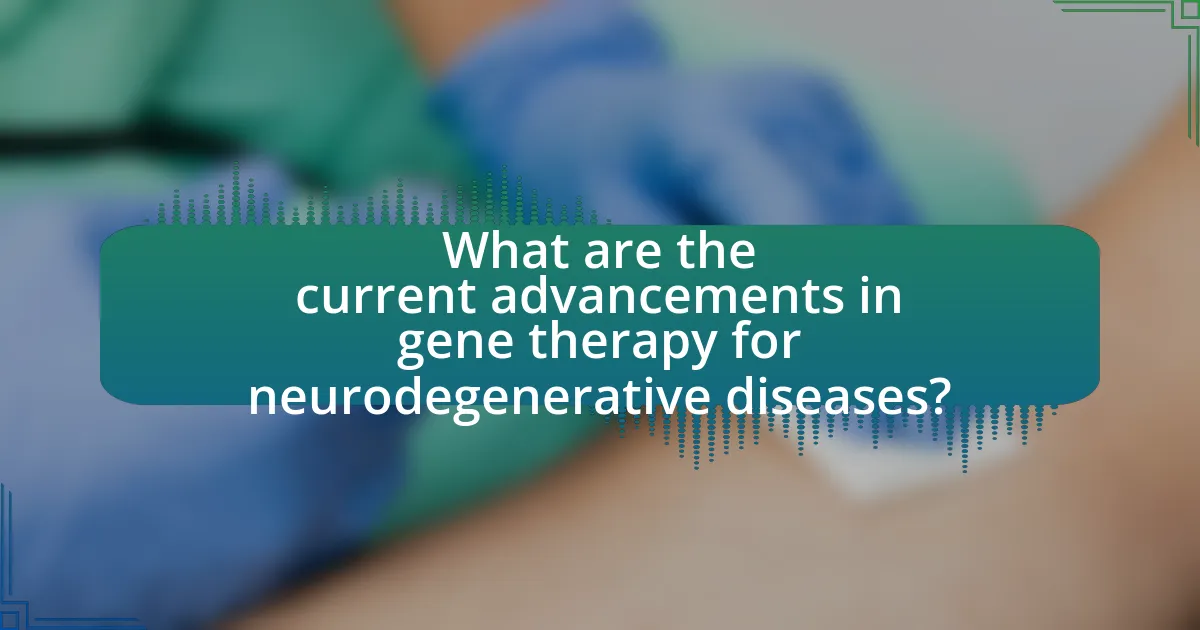
What are the current advancements in gene therapy for neurodegenerative diseases?
Current advancements in gene therapy for neurodegenerative diseases include the development of adeno-associated virus (AAV) vectors for targeted delivery of therapeutic genes, which have shown promise in clinical trials for conditions like Alzheimer’s and Parkinson’s disease. For instance, a recent study published in Nature Biotechnology demonstrated that AAV-based gene therapy could effectively deliver the gene for neurotrophic factors, leading to improved neuronal survival and function in animal models of these diseases. Additionally, CRISPR-Cas9 technology is being explored to correct genetic mutations associated with neurodegenerative disorders, with preliminary results indicating potential for reversing disease pathology. These advancements highlight the growing potential of gene therapy as a transformative approach in treating neurodegenerative diseases.
What recent studies have shown promise in gene therapy applications?
Recent studies have shown promise in gene therapy applications for neurodegenerative diseases, particularly through the use of adeno-associated virus (AAV) vectors. For instance, a study published in the journal “Nature” by Foust et al. (2013) demonstrated that AAV-mediated gene therapy effectively delivered the SMN1 gene in a mouse model of spinal muscular atrophy, leading to significant motor function improvements. Additionally, research by Kordasiewicz et al. (2012) in “Nature” highlighted the potential of gene silencing techniques to reduce toxic protein levels in models of Huntington’s disease, showing a decrease in neurodegeneration markers. These findings underscore the efficacy of gene therapy in addressing the underlying genetic causes of neurodegenerative conditions.
What methodologies are being used in these studies?
The methodologies used in studies on the potential of gene therapy in treating neurodegenerative diseases include vector-based gene delivery systems, CRISPR-Cas9 gene editing, and RNA interference techniques. Vector-based systems, such as adeno-associated viruses, are employed to deliver therapeutic genes directly to target cells in the nervous system. CRISPR-Cas9 is utilized for precise gene editing to correct genetic mutations associated with diseases like Huntington’s and Alzheimer’s. RNA interference techniques are applied to silence harmful genes that contribute to neurodegeneration. These methodologies are validated by numerous studies demonstrating their efficacy in preclinical models, such as the research conducted by Kordasiewicz et al. (2012) in “Nature” which showed successful gene silencing in Huntington’s disease models.
How do these studies impact the future of neurodegenerative disease treatment?
Studies on gene therapy significantly enhance the future of neurodegenerative disease treatment by providing targeted approaches to address genetic causes of these disorders. For instance, research has demonstrated that gene therapy can effectively deliver therapeutic genes to neurons, potentially reversing or halting disease progression in conditions like Alzheimer’s and Parkinson’s. A notable example is the study published in “Nature” by F. Zhang et al. (2021), which showed that adeno-associated virus (AAV)-mediated gene delivery improved cognitive function in mouse models of Alzheimer’s disease. This evidence supports the notion that gene therapy could lead to more effective, personalized treatments, ultimately improving patient outcomes and quality of life.
What are the regulatory challenges facing gene therapy development?
Regulatory challenges facing gene therapy development include complex approval processes, safety concerns, and the need for long-term efficacy data. Regulatory bodies like the FDA and EMA require extensive preclinical and clinical trial data to assess the safety and effectiveness of gene therapies, which can prolong the development timeline. Additionally, the unique nature of gene therapies, such as their potential for off-target effects and the need for individualized treatment approaches, complicates standard regulatory frameworks. For instance, the FDA’s guidance on gene therapy emphasizes the importance of understanding the biological mechanisms involved and the potential risks associated with genetic modifications, which adds layers of scrutiny to the approval process.
How do regulatory bodies assess the safety and efficacy of gene therapies?
Regulatory bodies assess the safety and efficacy of gene therapies through a rigorous evaluation process that includes preclinical studies, clinical trials, and post-marketing surveillance. Initially, gene therapies undergo preclinical testing in laboratory and animal models to evaluate their biological activity and potential toxicity. Following successful preclinical results, clinical trials are conducted in phases to assess safety, dosage, and efficacy in human subjects, with each phase requiring approval from regulatory agencies such as the FDA or EMA. These agencies review data from clinical trials, including adverse event reports and efficacy outcomes, to determine whether the therapy meets safety and efficacy standards before granting approval. For instance, the FDA’s guidance on gene therapy emphasizes the importance of long-term follow-up studies to monitor any delayed adverse effects, ensuring comprehensive safety assessments.
What are the ethical considerations in gene therapy research?
Ethical considerations in gene therapy research include issues of consent, potential long-term effects, equity of access, and the implications of germline modifications. Informed consent is crucial, as participants must fully understand the risks and benefits of the therapy. Long-term effects remain uncertain, raising concerns about unintended consequences on health and the environment. Equity of access addresses the disparity in who can benefit from these therapies, as they may be expensive and not universally available. Germline modifications, which alter genes in a way that can be inherited, pose ethical dilemmas regarding the potential for “designer babies” and the societal implications of such changes. These considerations are essential to ensure responsible and equitable advancement in gene therapy research.
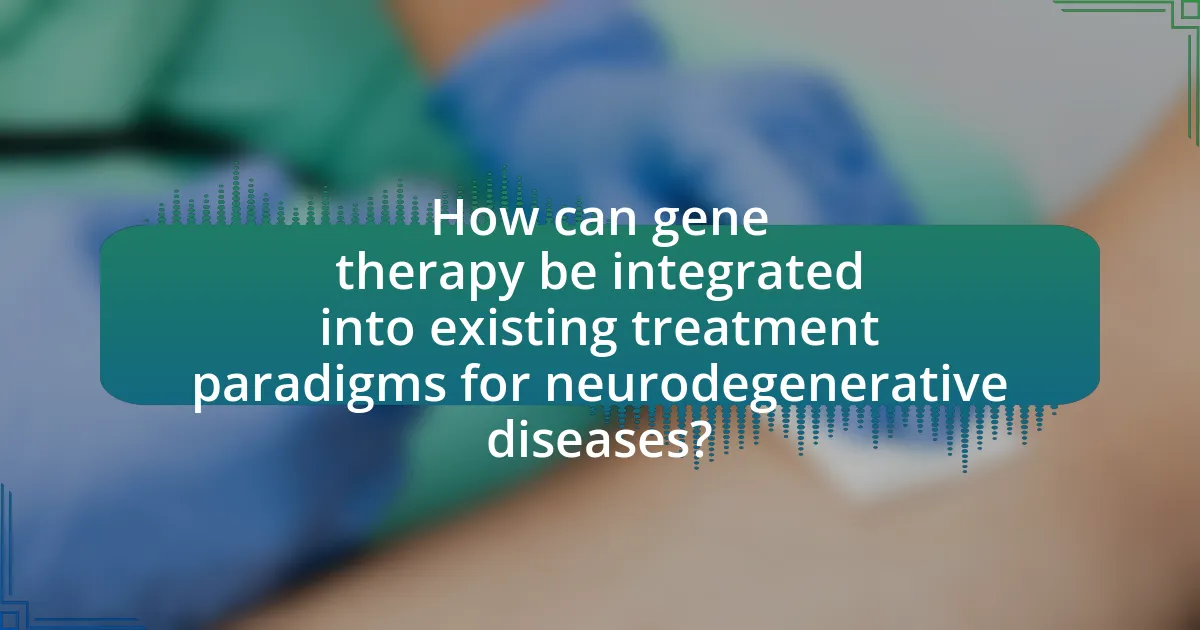
How can gene therapy be integrated into existing treatment paradigms for neurodegenerative diseases?
Gene therapy can be integrated into existing treatment paradigms for neurodegenerative diseases by targeting the underlying genetic causes of these conditions, thereby complementing traditional therapies. For instance, gene therapy approaches such as adeno-associated virus (AAV) vectors can deliver therapeutic genes directly to affected neurons, potentially halting or reversing disease progression. Clinical trials, such as those for spinal muscular atrophy (SMA) using the gene therapy Zolgensma, demonstrate significant improvements in motor function, indicating that gene therapy can effectively enhance existing treatment strategies. Furthermore, combining gene therapy with symptomatic treatments, like pharmacological interventions and physical therapy, can provide a more comprehensive approach to managing neurodegenerative diseases.
What role does gene therapy play alongside traditional therapies?
Gene therapy serves as a complementary approach to traditional therapies in treating neurodegenerative diseases by targeting the underlying genetic causes of these conditions. Traditional therapies often focus on managing symptoms, while gene therapy aims to correct or replace defective genes, potentially halting or reversing disease progression. For instance, in conditions like spinal muscular atrophy, gene therapy has demonstrated the ability to significantly improve motor function compared to standard care alone, as evidenced by the approval of the gene therapy Zolgensma, which has shown efficacy in clinical trials. This integration of gene therapy with conventional methods enhances overall treatment efficacy and offers patients a more comprehensive therapeutic strategy.
How can healthcare providers effectively combine gene therapy with other treatments?
Healthcare providers can effectively combine gene therapy with other treatments by utilizing a multidisciplinary approach that integrates gene therapy with conventional therapies, such as pharmacological treatments, physical therapy, and supportive care. This integration allows for a synergistic effect, enhancing the overall efficacy of treatment regimens. For instance, in the case of neurodegenerative diseases like Alzheimer’s, combining gene therapy aimed at delivering neuroprotective factors with existing medications can improve patient outcomes by addressing multiple pathways of disease progression. Studies have shown that such combinations can lead to improved cognitive function and reduced disease symptoms, demonstrating the potential for enhanced therapeutic benefits when gene therapy is used alongside traditional methods.
What are the potential risks of integrating gene therapy into treatment plans?
The potential risks of integrating gene therapy into treatment plans include unintended genetic modifications, immune reactions, and the possibility of tumorigenesis. Unintended genetic modifications can occur if the therapy affects genes other than the intended target, leading to unforeseen consequences. Immune reactions may arise as the body recognizes the introduced vectors or modified cells as foreign, potentially causing inflammation or other adverse effects. Additionally, there is a risk of tumorigenesis, where the insertion of therapeutic genes could disrupt normal cellular regulation, increasing the likelihood of cancer development. These risks highlight the need for thorough preclinical and clinical evaluations to ensure patient safety.
What are the best practices for patients considering gene therapy?
Patients considering gene therapy should engage in thorough consultations with healthcare professionals to understand the risks, benefits, and potential outcomes of the treatment. This practice ensures that patients are well-informed about their specific condition and the suitability of gene therapy as a treatment option. Additionally, patients should seek out clinical trials that are relevant to their condition, as these trials often provide access to cutting-edge therapies and comprehensive care. Research indicates that participation in clinical trials can lead to better health outcomes, as they are closely monitored and often provide additional support and resources. Furthermore, patients should maintain open communication with their healthcare team throughout the process, as ongoing dialogue can help address concerns and adapt treatment plans as necessary.
How should patients prepare for gene therapy treatments?
Patients should prepare for gene therapy treatments by undergoing thorough medical evaluations and consultations with their healthcare providers. This preparation includes understanding the specific gene therapy being administered, potential risks, and expected outcomes. Additionally, patients may need to undergo genetic testing to identify suitable candidates for the therapy, as well as to assess any pre-existing conditions that could affect treatment efficacy. Research indicates that proper patient education and pre-treatment assessments significantly enhance the success rates of gene therapies, particularly in neurodegenerative diseases.
What resources are available for patients seeking information on gene therapy?
Patients seeking information on gene therapy can access several reliable resources, including the National Institutes of Health (NIH) Genetic and Rare Diseases Information Center, which provides comprehensive information on gene therapy and related conditions. Additionally, the American Society of Gene & Cell Therapy offers educational materials and updates on ongoing research and clinical trials. The Food and Drug Administration (FDA) also provides resources regarding approved gene therapies and safety information. These organizations are credible sources that ensure patients receive accurate and up-to-date information on gene therapy options and advancements.
